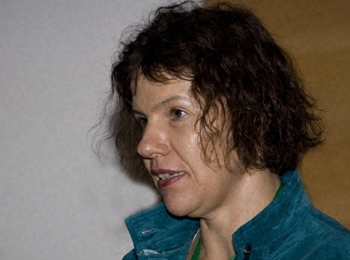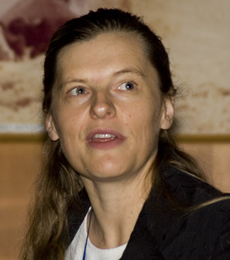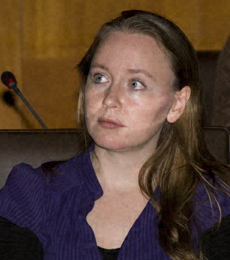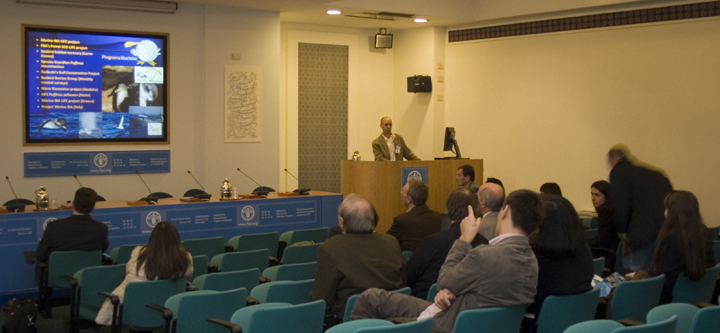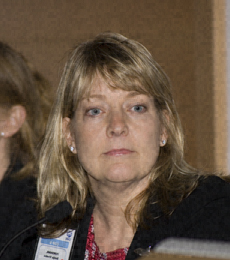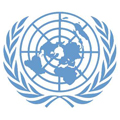

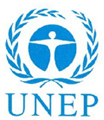


Year of the Dolphin
Presented by CMS and YoD Partners
Veronika Lenarz, Convention on the Conservation of Migratory Species of Wild Animals (CMS), opened the event by introducing the Year of the Dolphin (YoD) partners and thanking them for the two-year partnership.
Robert Hepworth, CMS Executive Secretary, expressed his satisfaction with the global success of YoD and highlighted the lessons learned from the project. He drew attention to the enthusiastic endorsement of many member states and partners to promote the YoD agreement.
Veronika Lenarz, CMS, explained that the organizations involved were UNEP, CMS, the Agreement on the Conservation of Small Cetaceans of the Baltic and North Seas (ASCOBANS), the Agreement on the Conservation of Cetaceans in the Black Sea, Mediterranean Sea and Contiguous Atlantic Area (ACCOBAMS), Touristik Union International AG (TUI), Whale and Dolphin Conservation Society (WDCS) and many goverments, such as Germany, France, Monaco and Kenya. She said the global response to the campaign was positive, with approximately 140 requests worldwide for supporter status. Lenarz outlined the outreach activities under the YoD flag, such as: promoting the European launch of the UNEP-supported IMAX movie “Dolphins and Whales 3D;” making available multilingual educational publications; developing workshops, lectures and exhibitions; and promoting educational activities in schools and at grass-root level.
Marie-Christine Grillo-Compulsione, ACCOBAMS Executive Secretary, noted YoD activities and the participation of ACCOBAMS and other partners.
Alison Wood, WDCS, said her organization focused on the Dolphin Diploma, a tool that allowed children to be actively involved in dolphin conservation activities. She noted that after being awarded the Dolphin Diploma, children were expected to develop a number of activities, and could share their designs and poems with other children online. Wood said the project was developed in many countries, including Colombia, India and Cape Verde. She said the manual “All about dolphins” was available in nine different languages for children, teachers and interested parents to have fun and learn more about dolphins. Wood said WDCS is looking to continue to develop the Dolphin Diploma around the world, help different groups of children and schools and inspire future generations to be ambassadors of the ocean.
Mike Brauner, TUI, said TUI signed a memorandum of understand with CMS to cooperate in the Year of the Sea Turtle and in the YoD, and publish on the issues of wildlife watching and tourism. He said TUI has been raising public awareness via TUI destination managers, and developing topics related to dolphin protection with local communities, especially in Kenya. Brauner highlighted the distribution of the manual “All about dolphins” in Kenya, Dominican Republic, Sri Lanka, Portugal, Canary Islands and Cape Verde. He noted that from all online products sales of the TUI shop a fixed amount goes to support CMS projects.
http://www.cms.int
http://www.accobams.org
http://www.wdcs.org
http://www.tui.com
http://www.tui-shop.com
Robert Hepworth <rhepworth@cms.int>
Marie-Christine Grillo-Compulsione
<mcgrillo@accobams.net>
Alison Wood <alison.wood@wdcs.org>
Mike Brauner <mile.brauner@tui.com>
Migratory species and people – a mutually beneficial future
Presented by WWF International
Susan Lieberman, WWF International, said the event focuses on different approaches of species conservation and people, and underlined that species conservation requires consideration of people, and that livelihoods also requires consideration of species. She focused on the results of a study that was framed by the question, “how does species conservation deliver on the Millennium Development Goals (MDGs),” with an outline of six case studies available online. She said the study’s key lesson was the need for project design to incorporate systems to measure species and livelihoods benefits.
Elisabeth McLellan, WWF International, reported on a study focusing on how wildlife trade supports livelihoods, undertaken in collaboration with TRAFFIC. She said the study on wild meat trade in East and Southern Africa, trade in wildlife skins and fibres in Latin America and Asian coastal fisheries products found that trade contributed to the MDG goals of education, gender equality, health, environmental sustainability and global partnerships for development. McLellan underscored that the approach can support the conservation of species listed on CMS Appendix II and the Addis Ababa Principles and Guidelines for the Sustainable Use of Biodiversity, and underlined the need to consider local community livelihoods in such conservation programmes. She concluded that maximizing benefits for people and species calls for effective biodiversity governance and land tenure systems, local community knowledge of sustainable use limits, and certification and standards systems that can also be used by communities.
Wendy Elliott, WWF International, argued that conflicts between local communities and wildlife can be minimized, using case studies of community-elephant conflicts in Namibia, Nepal and Indonesia. She said the study found a high association between community tolerance of elephant damage and community ownership of the benefits from trade in elephant products. To address conflict, she emphasized the need to give ownership of the wildlife to the communities living with the wildlife because they suffer the impact. Elliott stressed the relevance of land-use planning, highlighting that there is a relationship between: proximity to the wildlife habitat and destruction; land fragmentation and conflict; and forest use and habit conflicts. She emphasized, inter alia: the importance of coordination among all ministries and provision of appropriate financial resources to communities for their losses.
Mamadou Diallo, WWF Western African Marine Ecoregion, argued that it is possible to combine marine turtles conservation and livelihoods, and presented case studies from Cape Verde, Guinea and Senegal. He demonstrated how conflicts over marine turtles were addressed through, inter alia, awareness-raising campaigns targeting different age groups and training sessions to survey and monitor marine turtle programmes. He said measures taken include the establishment of: nesting sites for marine turtles identified by local fishermen and protected by local communities; an association to protect and conserve the turtles; micro-credits to provide alternative livelihoods; and a sustainable turtle tourism from the reserves. Diallo emphasized the need to identify the main actors in species use.
In the discussion, participants highlighted the need to: attend to the gender dimension in projects; address conflicts in marine conservation; and distinguish between illegal and alternative trades. Some participants drew attention to the prevalence of species-conservation conflicts and poor countries and the disproportionate incomes between middle-people and communities, due to asymmetries in information and the negotiation capabilities of communities.
Elizabeth McLellan <lmclellan@wwfint.org>
Wendy Elliott <welliott@wwfint.org>
Mamadou Diallo <mdiallo@wwfsenegal.org>
IBAs (Important Bird Areas) approach for completing SPAs network in the marine offshore environment
Presented by Italy and Italian Ministry for Environment, Land and Sea - Directorate-General for Nature Protection and Italian League for Bird Protection (LIPU)
Dupré Eugenio, Ministry of Environment, Italy, said that the ministry was focusing on designating protected areas for birds in the coastline marine environment. He noted that in 2007, the ministry started expanding data collection beyond coastal area, in a partnership with BirdLife International and LIPU, to identify marine important bird areas (IBAs).
Robert Clay, BirdLife International, highlighted the types of marine IBAs, which comprise of: areas near breeding colonies; concentrations of non-breeding individuals in coastal areas; pelagic foraging areas; and migratory routes and bottlenecks. He summarized the information of the BirdLife Seabird Foraging database, which is a comprehensive review and collation of data on seabird foraging ranges. Clay explained the uses of the data, including combining information on habitats, water depth, the ecology of species and the environment at the site. He said the system is also useful for comparing average and maximum foraging ranges. Clay noted a considerable amount of seabird foraging data in fact sheets that are available online. He gave an example of remote tracking and boat surveys in Spain, and explained how marine IBA identification, delimitation and designation are developed. He said the system helps to identify the greatest risks to seabirds and how to manage identified threats.
Pedro Geraldas, Portuguese Society for the Study of Birds (SPEA), presented the Marine IBA LIFE Project that aims to identify marine IBAs in Portugal. He noted the project’s activities on seabird habitat recovery and the importance of expanding multidisciplinary partnerships. He said the methodology used was the Mediterranean European Seabirds at Sea (ESAS) database and provides for easy data comparison. He stressed that: data collection should be carried out throughout the year; and more data needs to be gathered for some areas, where there are few or no surveys. Geraldas said it is crucial to develop cross-bird densities with sea characteristics to obtain predictive models for non-surveyed areas and to study seabirds accidental death by fishing practices. He outlined preliminary results from the project, including the identification of two off-shore IBAs, and said future activities will encompass: transforming IBAs into Special Protected Areas (SPAs); gathering more data; and developing pilot studies on the management of marine areas.
Claudio Celada, LIPU, focused on marine IBAs as a tool for widening the Natura 2000 Networking programme, the Europe-wide network of sites tasked with the preservation of the European natural heritage. He described the activities carried out in identifying areas and collecting data. He said the project aims at identifying important areas for the conservation of birds and their habitats, increasing knowledge on the ecology of seabirds, identifying main colonies and foraging sites, verifying the standardized ESAS methodology, and drafting a preliminary list of marine IBAs.
http://www.birdlife.org
http://www.spea.pt/MIBA
http://www.lipu.it
Robert Clay <robclay@birdlife.org>
Pedro Geraldas <pedro.geraldas@spea.pt>
Claudio Celada <claudio.celada@lipu.it>
Conservation and management of migratory sharks
Presented by IUCN
Susie Watts, Humane Society International, said the presentations would provide an update on the conservation status of migratory sharks in general, and on pelagic sharks specifically, in the context of COP 9 species listing proposals.
Sarah Fowler, IUCN/SCC Shark Specialist Group, highlighted: the intrinsic and extrinsic factors that render sharks vulnerable; the related management challenge; and ongoing work to address their vulnerability. She presented the results of a 2007 Red List assessment that examined 1,038 chondrichthyan species. Fowler said the study found that migratory shark species are more seriously threatened than the entire taxonomic group combined, in part because non-migratory species: are easier to manage; tend to reside in deep waters; and a majority of the species is in Australian waters, where there is good management. Fowler concluded that the primary threats include poor fisheries management, and noted there is a lack of data and information. She noted the report was available online.
Drawing on her experience in the North Atlantic region, Sonja Fordham, Shark Alliance, focused on pelagic sharks, specifically the Longfin and Shortfin Mako, Spiny Dogfish and Porbeagle sharks. She described each of their characteristics, economic values, major markets, sources of vulnerability, and statuses on the Red List. She noted that little activity has been carried out to promote shark sustainability, and stressed the potential for the CMS Appendix II listing to: facilitate improved data collection, stocks assessments and understanding; help focus available funding; encourage cooperative conservation and management efforts for vulnerable species; and enhance the chance to develop sustainable fisheries.
In closing, Watts urged CMS parties to support the adoption of a binding agreement on sharks, even if it takes a little longer to be establish, considering: the exceptional vulnerability of migratory shark species; their exploitation in the absence of regulation and sustainability; and concerns expressed about sharks at the regional level, without any political will to act. She noted CMS precedents of relatively rapid adoptions of binding agreements, and said a binding agreement would benefit sharks “far more than an apparent quick-fix solution.”
http://www.iucnssg.org
http://www.sharkalliance.org
http://www.cms.int
Sarah Fowler <sarahfowler@naturebureau.co.uk>
Sonja Fordham <sonja@oceanconservancy.org>

